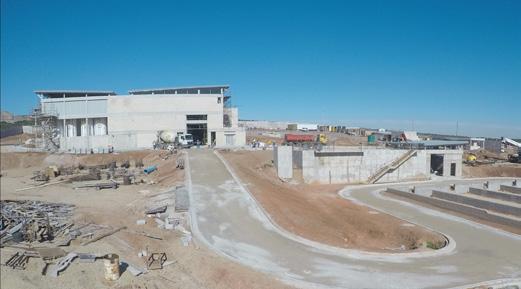
4 minute read
South Africa’s largest BIOFILTRATION PLANT NOW OPERATIONAL
from IMIESA April 2023
by 3S Media
Part of the Coegakop Wellfield Project, the Coegakop Water Treatment Works (WTW) is designed to treat groundwater to potable standards for drought-stricken Nelson Mandela Bay Municipality (NMBM).
Not only the largest biofiltration plant of its kind in South Africa, the Coegakop WTW is possibly the most ambitious biological manganese removal plant in the world (treating high concentrations up to 2 500 mg/ ℓ ).
Advertisement
Preekstoel Plant in Hermanus is the only other biofiltration plant of this kind in the country, but it can only treat 10 M ℓ /day, as opposed to the 20 M ℓ /day treatment capacity of the Coegekop WTW
What is biofiltration and why use it?
Biofiltration is a biological method of treating water whereby a specific culture of autotrophic bacteria is allowed to grow on a filter media to aid in the removal of dissolved minerals. These bacteria are chemosynthetic, utilising chemical energy released when they use oxygen to oxidise the metals. They are of the same type of bacteria as those found in wastewater treatment works to convert ammonia to nitrate and are harmless to humans.
“The Coegakop WTW uses biofiltration technology because it is an affordable, efficient, sustainable and reliable treatment solution with low maintenance costs. The normal filtration process requires the use of more chemicals, so this approach reduces our operational cost and is also better for the environment,” explains Matthew Hills, civil engineer: Water & Sanitation Subdirectorate, NMBM.
Hills adds that the cost per kilolitre of water is less than alternative water sources for NMBM. “NMBM is confident that Coegakop will supply the lowest cost per kilolitre of water within the NMBM water supply system. Aside from the iron and manganese elements, the water is pristine and characterised by low levels of salinity.”
Besides the water purification, there are negligible bulk water transfer costs, since the treated water goes straight to the existing Coegakop reservoir approximately 650 m away. From there, distribution pipelines supply areas of Motherwell, Colchester and the Coega SEZ.
“Having a second source of water supplying the Coega SEZ is essential for investor confidence and will unlock the potential for further development and job creation,” says Hills.


The treatment process primarily involves biological oxidation and filtration of iron and manganese, as well as the stabilisation and disinfection of groundwater from the Coegakop Wellfield.
Groundwater initially enters the works at the raw water inlet chamber where pH and oxygen levels are adjusted before the water is distributed to the sand filters. Interesting, the water temperature is around 27 ° C due to the depth of the aquifer.

There is a two-stage biofiltration treatment process removing iron and then manganese. The iron and manganese in the groundwater are initially in a dissolved state and cannot be removed by conventional filtration alone. Inside the filters are dedicated strains of bacteria that are cultivated to facilitate the oxidation of iron and manganese. Solid precipitate particles are formed and then filtered out.
The filtrate then flows by gravity through a packed limestone bed, stabilising the pH levels. From there, it moves into a treated water storage tank. A residual dose of chlorine (as calcium hypochlorite) is added into the treated water storage tank, controlled by a chip-feeder dosing system. This is done to protect water against downstream contamination. The treated water is then pumped to the Coegakop reservoir for distribution to NMBM communities.
The filters are backwashed with a combined water/air-scour system, drawing water from the manganese filtrate tank, and supplying air from dedicated backwash blowers. The spent backwash water is fed to backwash water recovery ponds where the solid residue settles, and the supernatant is pumped back to the head of the works. Settled solids are allowed to dry over time and are periodically removed for disposal off-site.
The project showcases NMBM’s ability to deliver highquality, innovative infrastructure to the community

This treatment process relies on interstage filter feed pumps, backwash pumps, backwash blowers and treated water high-lift pumps.
Sophisticated monitoring and control
Automated control and instrumentation systems will ensure that the treatment process operates effectively and that the process controllers can monitor all activities centrally. Automated reporting will be generated, assisting with compliance reporting. This is primarily done through a Scada system.
“NMBM is refining its ability to operate plants remotely, as well as record, view and manage data. With the drought, the balance between water demand versus available supply is precarious and we need to react rapidly to any changes within this system. Adopting a modern Scada system is a huge step in the right direction towards achieving an optimised, efficient and reliable water supply system,” explains Hills.
The water temperature is around 27°C due to the depth of the aquifer.
The boreholes at Coegakop are equipped with level and flow sensors linked to the Scada system. Overall, this determines how abstraction rates affect the overall aquifer. Effects of abstraction are monitored on boreholes further upstream of the Coegakop Wellfield near Kariega. This information is transferred to the Coegakop WTW and shown on the plant Scada. This will ensure that timely interventions can be made to the abstraction rates to prevent any detrimental groundwater draw-down effects and negative impacts to existing aquifer users.
The data will also prove invaluable for the Department of Water and Sanitation in monitoring aquifer health and water use in terms of the licensed aquifer abstraction.
In conclusion
The project involved rigorous and highly collaborative interaction between the client, engineers, architects, hydrogeologists, environmental practitioners, 3D software modellers and virtual reality programmers.
“The Coegakop WTW is an incredible achievement. It showcases NMBM’s ability to deliver high-quality, innovative infrastructure to the community, and it is a strong reminder that we as South Africans can and should take a leading role in solving our own water challenges,” Hills concludes.










